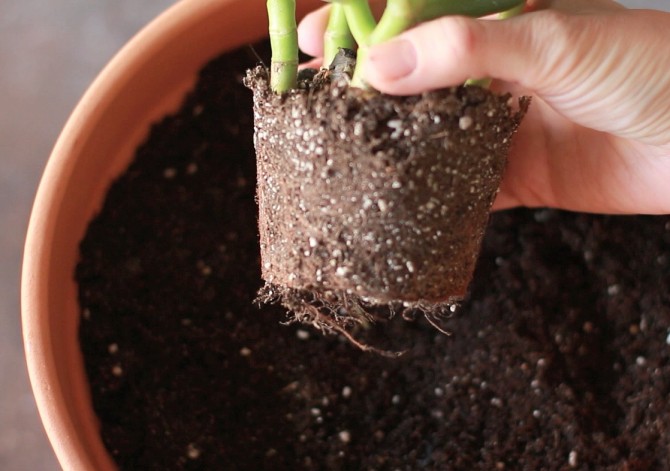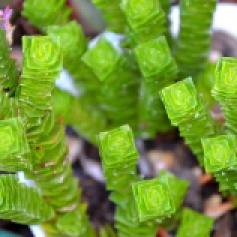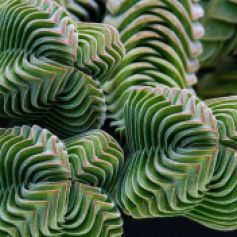Impeccably manicured plants, in beautiful and eclectic containers. Seems daunting to pick a plant for someone like this.
For whatever reason, succulents make great gift plants. They can be inexpensive, small in size, and can go with strictly anything style-wise.
It can be done. Skip to the end if you know what you’re doing. You’ll find the coolest varieties (in my opinion) featured there.
Here I’ll explain a few characteristics about plants, we’ll look at some examples, and you’ll be an expert.
Apical Meristem

At the center, where new the plant stems and leaves form, is called the apical meristem. There is one (1) in this picture. Decide how many you see in the next image. Only count ones that are clearly visible.

How many are there?

I counted 8. Number 4 is sort of hidden, so I would accept 7 as an answer.
The more apical meristems, the greater the plants age. It could also suggest the grower planted multiple stems in one pot to make it attractive to customers. Abundance is generally an attractive trait to plant shoppers, but when it comes to a collector, there are many intricacies to consider. Let’s talk for a minute about what makes a plant beautiful.
Can a plant be pretty?
Truthfully, whether a plant is beautiful or not is a factor of how it is framed. Stark black and white photographs look great in a simple unremarkable frame. An intricate frame can add life portrait. Consider these examples.

The common name for this is Jade Plant. Well-liked among all skill levels, its color and wide varieties make it special. It does not have an eye-catching pattern in its leaves and stems. However, with the addition of this container, the green really jumps out at you. A strong blue would have pulled the eye away from the plant. The cracked pattern and light blue color are pleasing and frame the plant’s color and form perfectly. A matte black or grey would have worked just as well in my opinion.

It helps that the photographer used a macro lens to capture the small scale of this Echeveria “Doris Taylor”. But looking at it in person would bring you the same feeling. Just like the stark photograph in an unremarkable frame, this small unremarkable pot brings out the succulent’s fragility, and highlights its distinct leaves. It’s like a tiny puppy of a plant and it screams “CUTE!” Small pots require one single apical meristem, no matter the type of plant, otherwise its fragility is overlooked. Dainty small leaves like some Crassulas are the exception. Speaking of fragility…
Health

Make sure it is healthy before you buy it. You know a plant is healthy if the leaves are plump and rigid. Leaves with wrinkles and soft fleshy insides like the leaf on the bottom right may be dying. Brown discoloration, like at the bottom center, means its cells are dead. In this case bacteria or fungi may already be working to turn this into compost.
If your selection has a rigid stem and leaves, and shows no signs of discoloration, buy it. Don’t despair if a succulent looks healthy but is planted in dry soil. It’s a sign of a healthy plant. Here’s why.
Fast Growers

Chances are the nursery offers their succulents with bone-dry soil. They will water theirs more along the lines of once every two weeks, and that is how it should be. Dry climates in their native habitat forces them to have fast growing roots, to take advantage of soil moisture while it lasts. Your plant loving friend probably knows this. It’s is how succulents like to live. If their plants are in moist soil, trust that they take good care of the plants, and make sure to look for all the other signs of a healthy plant.
Bonus: Check out PBS Kids’ DIY Succulent Container Garden! It’s a great guide for us all.
A Few Fun Varieties
What you see is Sempervivum pittonii at the top, and at bottom, from left to right is; a square stemmed Crassula species, Crassula “Buddha’s Temple”, and Crassula ovata.
With the Sempervivum, what you are looking at is the beginnings of the flower stalk taking form. Each light colored mass will become a flower. I count 14! How many apical meristems do you count on the bright green crassula at bottom left?
These are all exciting and interesting picks. Pattern, flower form, and color. Brilliant. See some other interesting picks at: thesucculentgarden.com/au
I hope you found this useful. Please leave a comment with your favorite succulent variety, you may make someone’s birthday or holiday bright. Thank you for dropping by!
P.S. Enjoy the falling snow on the blog. It’s there until January 4th. Happy Holidays! Or Happy Spring if you’re from Australia.



